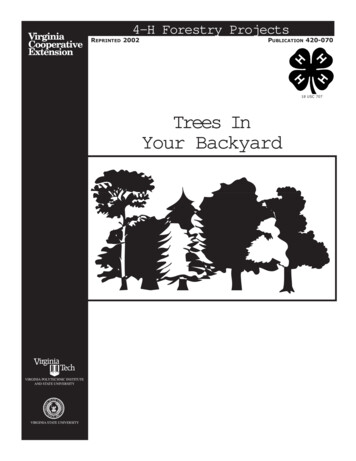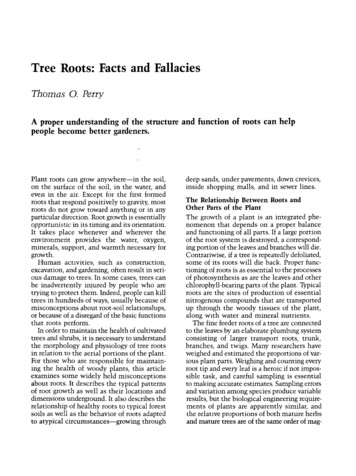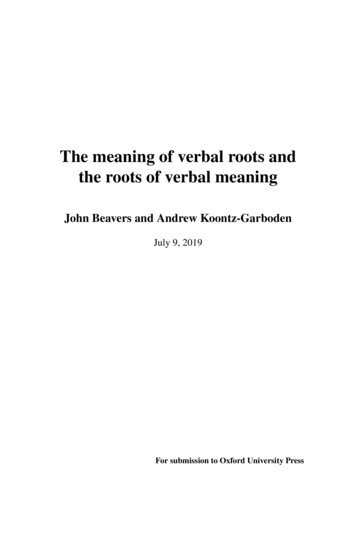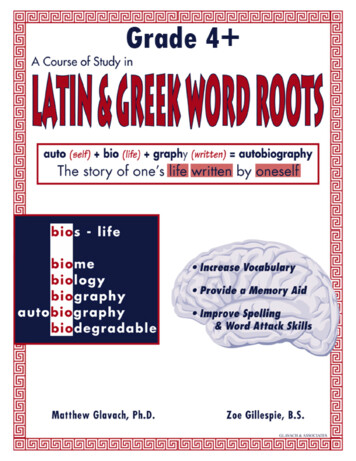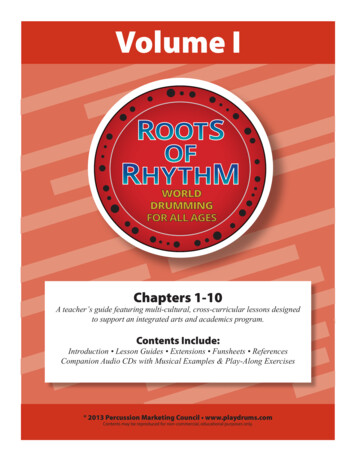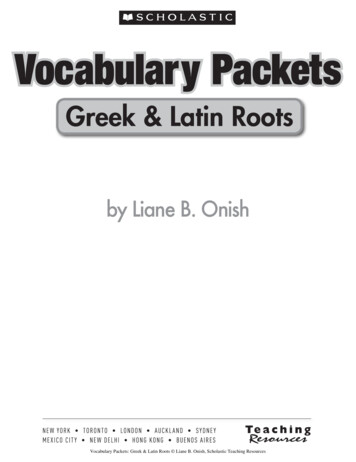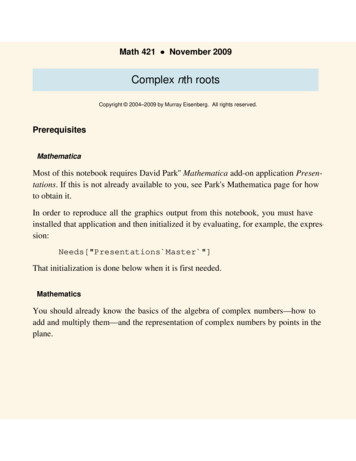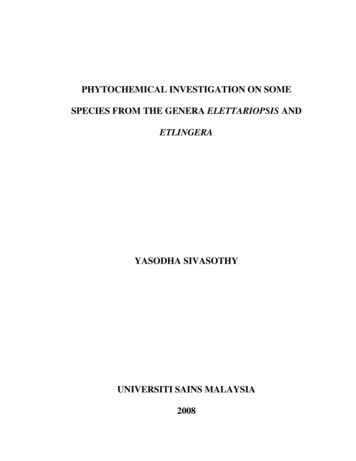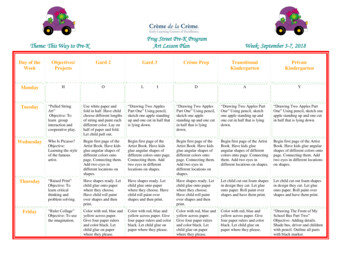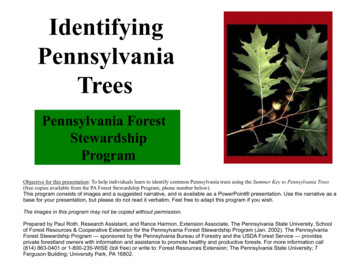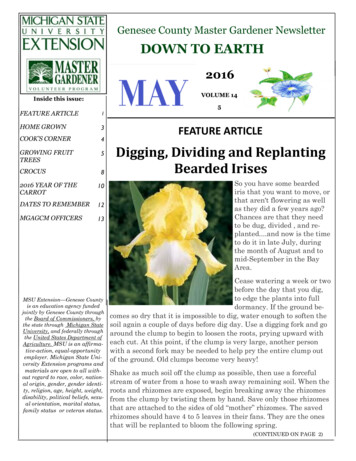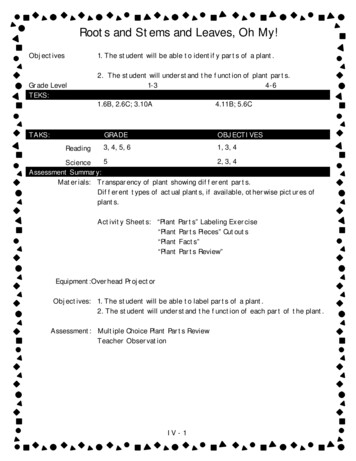
Transcription
Roots and Stems and Leaves, Oh My!Objectives1. The student will be able to identify parts of a plant.Grade LevelTEKS:2. The student will understand the function of plant parts.1-34-61.6B, 2.6C; 3.10ATAKS:Reading4.11B; 5.6CGRADEOBJECTIVES3, 4, 5, 61, 3, 452, 3, 4ScienceAssessment Summary:Materials: Transparency of plant showing different parts.Different types of actual plants, if available, otherwise pictures ofplants.Activity Sheets: “Plant Parts” Labeling Exercise“Plant Parts Pieces” Cutouts“Plant Facts”“Plant Parts Review”Equipment:Overhead ProjectorObjectives: 1. The student will be able to label parts of a plant.2. The student will understand the function of each part of the plant.Assessment: Multiple Choice Plant Parts ReviewTeacher ObservationIV - 1
Background InformationRoots and Stems and Leaves, Oh My!Plants have different parts just like we do. We have arms, legs, a heart and lungs tohelp us survive. Each of our body parts has a certain job to do. Plants have differentparts, each with its own job to do. They must have roots, stems and leaves. Each part ofthe plant must do its job so the plant can stay healthy and grow.RootsA plant’s roots grow under the ground. The roots help hold the plant in the soil. Theyalso take in water and nutrients which the plant turns into food. Plants have differentkinds of root systems. Some plants have fibrous roots. Fibrous roots have many branchesand spread out like the branches of a tree. Plants that have fibrous root systems includegrasses, corn plants, wheat and many other crops that farmers grow. Other plants have atap root. This is a single, main root that grows straight down. The tap root has smallerbranches growing off of it. Examples of plants that have a tap root are carrots, radishesand turnips.StemsThe stem grows upward from the roots. It holds the plant up and carries water fromthe roots to the other parts of the plant. Secondary stems, called petioles, grow from themain stem. These petioles have leaves growing on them. Sometimes we eat the stems ofplants, like celery and asparagus.LeavesThe leaves of a plant make the food the plant needs to survive. The water andnutrients that were taken in by the roots, move upward through the stem to the leaves.The leaves take sunlight and carbon dioxide from the air and convert the nutrients toplant food. This process is called photosynthesis. We eat the leaves of some plants such aslettuce and spinach.Flowers, Fruit and SeedsWhen a plant receives the proper amount of water, nutrients, air and sunlight itproduces flowers. The flowers usually grow on the stems. When the flower dies and fallsoff it leaves behind a fruit. The fruit contains seeds. Fruits that we eat include apples,oranges, watermelons and tomatoes. Sometimes we let the seeds dry out and use them forfood. Things like corn, peas and beans are examples of seeds that we eat.The seed is the part that grows a new plant. If we plant a bean seed we will get aplant just like the one that made the seed.IV - 2
Roots and Stems and Leaves, Oh My!Lesson Plan1.Introduce new vocabulary:Grades 1-3Grades 5-6RootStemPetioleLeafNutrientsCarbon DioxideFibrous RootsTap RootFlowerFruitSeedPhotosynthesis2. Show students a plant, either actual or make a transparency from the enclosed diagram.3. Ask students to try to identify as many of the parts as possible.4. Next, ask students to begin listing what they think is the function of each of theparts.5. Read Background Information to the class or have each student read individually.6. Go over the parts of a plant in detail. Also explain each function.7. Show plants with different types of leaves, stems and roots. Emphasize that eventhough the parts may look different they all have the same function.8. Have lower grade levels cut out “Plant Parts Pieces” and paste to “Plant Parts Card”,then color the picture.9. As appropriate to grade level have students read “Parts of a Plant” and label thediagram.10. Show overhead transparency of a corn plant. What type of root system does a cornplant have? Where are the seeds located? Have students research the function of thetassel and the silks on the corn plant.ExtensionHave students make a collection of plants that show different leaf, stem and rootcharacteristics.IV - 3
Plant PartsIV - 4
Plant FactsCircle the letter in the correct column for each statement .TrueFalse1. Plants have three parts: the root, the stem, andthe carbon dioxide.HY2. Plants can live without water.IO3. Roots hold a plant in the ground.UL4. Plants and animals produce their own food.OH5. Stems carry water from the roots to the leaves.AG6. Food is make in the leaves of green plants.VF7. All leaves look alike.RE8. Green plants need sunlight.EC9. All plants have chlorophyll.SA10. Seeds store food.RS11. Flowering plants produce fruit.SDWhat do you have that a corn plant has?To find out, fill in the letters you circled above on the lines ofthe question numbers below.1234567IV - 8!891011
Plant Parts ReviewCircle the correct answer.1. A plant has roots which keep ita) in the groundb) livingc) from getting cold2. The main stem above the ground helpsa) the bugs bring foodb) the flowers bloomc) carry water throughout the plant3. The secondary stems grow out from the main stem, and these stems havea) thistlesb) flowersc) leaves4. Green leaves make most of the plant’sa) chlorophyllb) foodc) seeds5. The flowers of the plant producea) seedsb) fruitc) leaves6. Roots and stems carrya) sunlight and sugarb) nutrients and waterc) carbon dioxide and sugar7. Photosynthesis takes place in thea) rootb) leavesc) stemIV - 9
ANSWER KEYParts of a PlantPlant Parts PetiolesMain stemRootsPlant Facts1. Y2. O3. U4. H5. A6. V7. E8. E9. A10. R11. SYou Have Ears!IV - 10ACCBBBB
a) the bugs bring food b) the flowers bloom c) carry water throughout the plant 3. The secondary stems grow out from the main stem, and these stems have a) thistles b) flowers c) leaves 4. Green leaves make most of the plant's a) chlorophyll b) food c) seeds 5. The flowers of the plant produce a) seeds b) fruit c) leaves 6. Roots and stems carry
